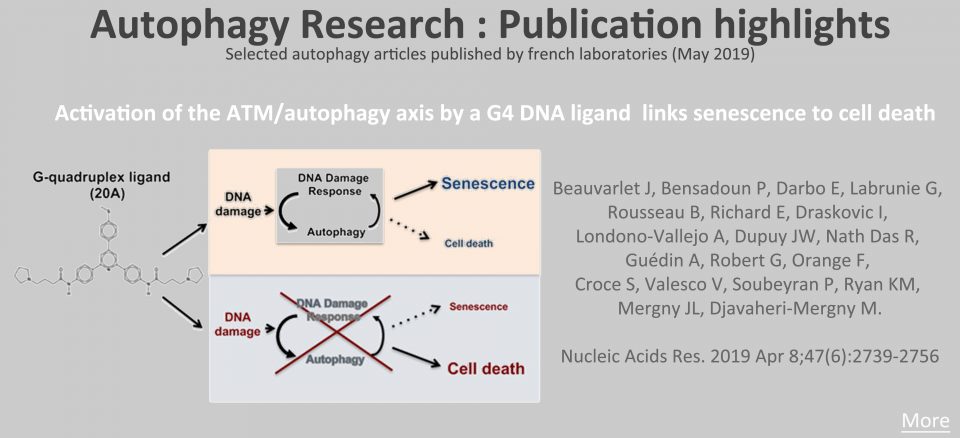Modulation of the ATM/autophagy pathway by a G-quadruplex ligand tips the balance between senescence and apoptosis in cancer cells
Authors
Jennifer Beauvarlet, Paul Bensadoun, Elodie Darbo, Gaelle Labrunie, Benoît Rousseau, Elodie Richard, Irena Draskovic, Arturo Londono-Vallejo, Jean-William Dupuy, Rabindra Nath Das, Aurore Guédin, Guillaume Robert,Francois Orange, Sabrina Croce, Valerie Valesco, Pierre Soubeyran, Kevin M Ryan, Jean-Louis Mergny, and Mojgan Djavaheri-Mergny
Link to the original articleYear of publication
2019
Journal
Nucleic Acids Res
Abstract
G-quadruplex ligands exert their antiproliferative effects through telomere-dependent and telomere-independent mechanisms, but the inter-relationships among autophagy, cell growth arrest and cell death induced by these ligands remain largely unexplored. Here, we demonstrate that the G-quadruplex ligand 20A causes growth arrest of cancer cells in culture and in a HeLa cell xenografted mouse model. This response is associated with the induction of senescence and apoptosis. Transcriptomic analysis of 20A treated cells reveals a significant functional enrichment of biological pathways related to growth arrest, DNA damage response and the lysosomal pathway. 20A elicits global DNA damage but not telomeric damage and activates the ATM and autophagy pathways. Loss of ATM following 20A treatment inhibits both autophagy and senescence and sensitizes cells to death. Moreover, disruption of autophagy by deletion of two essential autophagy genes ATG5 and ATG7 leads to failure of CHK1 activation by 20A and subsequently increased cell death. Our results, therefore, identify the activation of ATM by 20A as a critical player in the balance between senescence and apoptosis and autophagy as one of the key mediators of such regulation. Thus, targeting the ATM/autophagy pathway might be a promising strategy to achieve the maximal anticancer effect of this compound.
Graphical abstract
